![]()
![]()
![]()
Use LEFT and RIGHT arrow keys to navigate between flashcards;
Use UP and DOWN arrow keys to flip the card;
H to show hint;
A reads text to speech;
126 Cards in this Set
- Front
- Back
- 3rd side (hint)
|
What sort of response does the innate immune system provide? |
An immediate response to infection that is non-specific and short term |
|
|
|
What are the features of the innate immune system? |
-Always on (constitutive) -Rapid response -Relatively non specific -No memory response -Doesn't get more effective after 2nd exposure -keeps infection under control unto adaptive immune response kicks in |
|
|
|
What are the features of the adaptive immune response? |
-requires priming by antigens -responds slowly -high specific -memory response -more effective with repeated exposures |
|
|
|
What are the 2 types of barriers against pathogens? |
Physical Chemical |
|
|
|
What are the physical barriers? |
-epithelial surfaces -ciliated epithelial in mucous membranes -mucus: adhesive barrier traps pathogens -peristalsis : moves pathogens through GI tract |
|
|
|
What are the chemical barriers? |
-lysozyme in saliva and tears (lacrimal ducts) -acidic pH in stomach and low pH of sweat Inhibits growth -sebum forms protective film: Inhibits growth of many microbes -antimicrobial proteins produced by epithelial cells -chemotactic signals secretes by epithelial cells to recruit immune cells |
|
|
|
What are the 8 cells of the immune system? |
Mast cell Macrophage Natural killer cell Dendritic cell Monocyte Neutrophil BasoPhil Eosinophil |
|
|
|
Which of the 8 innate immunity cells are considered granulocytes/ polymorphonuclear leukocytes? |
BasoPhil Eosinophil Neutrophil |
|
|
|
What is polymorphonuclear? |
(of a leucocyte) having a nucleus with several lobes and a cytoplasm that contains granules, as in an eosinophil or basophil. |
|
|
|
What is a leukocyte? |
A white blood cell |
|
|
|
Which of the 8 innate immunity cells are professional phagocytes? |
Neutrophil Dendritic cell Macrophages |
|
|
|
An example of dendritic cell? |
Langerhaan cells in epidermis of skin |
|
|
|
Examples of macrophage |
Kupffer cells in liver Microglia in CNS Histiocytes in connective tissues |
|
|
|
Which cells are agranulocytes? (don't have granules) |
Monocyte Lymphocytes |
|
|
|
Which cells are antigen presenting cells? |
Dendritic cells Macrophage B cells |
|
|
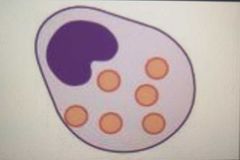
What cells is this? |
Mast Cell |
|
|
|
Where are mast cells found? |
Connective tissues Mucous membranes |
|
|
|
What are some of the characteristics of mast cells? What does it recruit? |
-dilate blood vessels and causes inflammation -recruits macrophages + neutrophils -involved in wound healing |
|
|
|
How do mast cells cause inflammation? |
Through the release or histamines and heparin. Thus can also be responsible for allergic reactions |
|
|
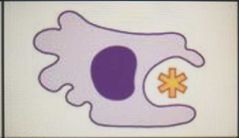
What cell is this? |
Macrophage |
|
|
|
Where are macrophages found? |
Live in tissues & lymphoid organs |
|
|
|
What are some of the characteristics of macrophages? |
-phagocytic cells which consumes pathogens + cancer cells -stimulates response of other immune cells |
|
|

What cell is this? |
Natural killer cell/ lymphocyte |
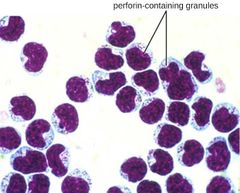
|
|
|
Where are natural killer cells found? |
Found in blood, spleen, liver, and gut |
|
|
|
What do natural killer cells do? |
Kill tumour cells and virally infected cells. Produce proinflammatory cytokines which enhance the adaptive immune response |
|
|
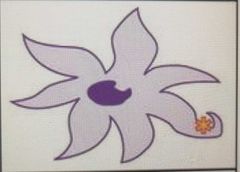
What cell is this? |
Dendritic cell |
|
|
|
Where are dendritic cells found? |
Connective tissues & body cavaties Lymph nodes (upon activation) |
|
|
|
What do dendritic cells do? |
Present antigens on its surface and triggers adaptive immunity |
|
|

What is this cell? |
Monocyte |
|
|
|
Where are monocytes found? |
Stored in spleen & move through blood vessels to infected tissue. Once in the tissue, they mature into macrophages |
|
|
|
What do monocytes do? |
Differentiate into macrophages & dendritic cells in tissues. In blood they're monocytes and ohagicytose dead cells and bacteria
Has one kidney shaped nucleus, largest cell in peripheral blood, contains lysosomes. No granules. |
|
|

What is this cell? |
Neutrophil |
|
|
|
Where are neutrophils found? |
Migrate from blood vessels to tissues |
|
|
|
What is the function of neutrophils? Which pathogens do neutrophils act on? |
-first responder -releases granules containing toxins, defebsins, lyzozomes to kill bacteria or fungi -recruits other immune cells -multi lobes nucleus |
|
|
|
Neutrophils make up what percentage of leukocytes? |

50-60 % (some say even 70%) |
|
|

What cell is this? |
Basophil |
|
|
|
What is the function of basophil? |
-defence against parasites -releases histamines and heparin increasing blood flow to site and this inflammatory response (involved in allergic reactions) -has IgE receptors |
|
|

What cell is this? |
Eosinophil |
|
|
|
What is the function of eosinophil? |
-Releases toxins that kill bacteria & parasites BUT also causes tissue damage - 2 lobes -part of inflammatory response |
|
|
|
If there is chronic inflammation, which cell is likely to have caused it? |
Monocytes |
|
|
|
Where do neutrophils develop? With the help of what? |
In bone Under the G-CSF growth factor |
|
|
|
What are the pale pink granules in neutrophil cells? |
Lysosomes containing digestive enzymes, antibacterial peptides and oxidising agents |
|
|
|
What do neutrophils become after their 1-4 day short life span? |
Pus cells |
|
|
|
Which three ways do neutrophils kill pathogen? |
-Phagocytosis -Degranulation (release digestive enzymes) -Neutrophil extracellular traps (physical barrier which traps pathogen in a Web of fibres) |

|
|
|
What is the function of heparin which is released in inflammatory responses? |
Prevents blood clotting |
|
|
|
Which is the least common blood cell? |
Basophil |
|
|
|
What colour do basophil granules stain? What do they contain? |
Blue/ purple
-histamine -heparin -chemokines -Pro inflammatory factors |
|
|
|
What Ig are basophil mediated by? |
IgE |
|
|
|
What two cells are morphologically similar? What are the differences? |
Mast cells vs basophil
-mast cells have 1000 small granules vs 80 large in basophil -mast cell nucleus is round vs basophil lobed nucleus -mast cells are filled with basophil granules but found in connective tissue vs basophil are which is type of immune cell found in blood + tissues |

|
|
|
What colour do eosinophil granules show up as? |
Bright red |
|
|
|
Where are abundant eosinophil found? |
Connective tissue lining of intestines + lungs of asmatic patients (blood levels of these cells are abnormally high in allergic conditions such as asthma & hay-fever) |
|
|
|
What are MHC molecules? |
Major histocompatibility complex (MHC) molecules / HLA (human leukocyte antigens) There basically unique cell surface molecules which present antigens to T cells |
|
|
|
Where is the MHC gene locus found? |
On chromosome 6 in the P (short) arm |
|
|
|
What are the two types of MHC molecules? |
Class I MHC & Class II MHC |
|
|
|
Where are class I MHC found? |
On all nucleated cells |
|
|
|
What are class I MHC recognised by? |
CD8+ cytotoxic T cells Via endogenous pathway MHC I recognises internal pathogens in the cells, eg. Virus |
|
|
|
Describe the structure of a MHC class I molecule |
3 x alpha segments 1 x B2 microglobulin |
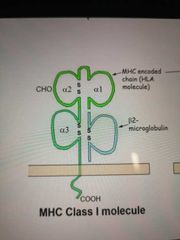
|
|
|
CD8 T cell structure (cytotoxic) |

a3 and CD8 are not connected |
|
|
|
Where are class II MHC found? |
On antigen presenting cells |
|
|
|
What are class II MHC cells recognised by? |
CD4+ helper T cells Via an exogenous pathway Detect external pathogens (virus floating in blood, bacteria etc...) |
|
|
|
Structure of the MHC class II molecule |

1 x beta chain 1 x alpha chain |
|
|
|
CD4 T cell structure (helper) |

CD4 & beta chains are joined |
|
|
|
Natural killer cells mechanism. Which receptors does it detect? |
- Natural killer cell inhibitory receptors recognise class I MHC -Virally infected/ tumour cells down regulates class I MHC leading to NK cell activation -NK releases chemicals from cytoplasmic granules |
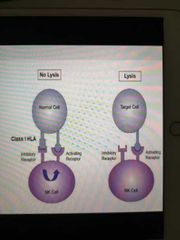
|
|
|
What do Natural killer cells secret from cytoplasmic granules? What do these do? |
Perforin & granzynes Granzynes enter target cell cytoplasm via perforin pores and induces apoptosis |
|
|
|
What is lysis? |
The disintegration of a cell |
|
|
|
What are B - cells? |
Part of adaptive immunity. They recognise a specific soluble antigen (IG) |

|
|
|
Where can B-cells be found? |
Lymphoid tissue Peripheral blood |
|
|
|
APC / MHC II exogenous pathway |

|
|
|
|
MHC I endogenous pathway |

|
|
|
|
TLR (Toll like receptors) -location -ligands (detect, are activated by) -ligand sources |
-Plasma membrane -DNA, RNA, LPS, DAMP, flagellin, peptidoglycan -Bacteria, viruses, parasites, self |

|
|
|
NLR (NOD-like receptor) -location -ligands -ligand sources |
-cytoplasm -DAMPS, muramyl dipeptides -self, bacteria |
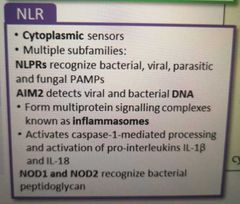
|
|
|
CLR (C-type lectin receptors) -location -ligands -ligand sources |
-Plasma membrane -beta-glucans -fungi |

|
|
|
RLR (Retionoic acid-inducible gene-1 like receptors) -location -ligands -ligand sources |
-cytoplasm -ds RNA -RNA virus |

|
|
|
What are PRRs (pattern recognition receptors)? Where are they usually found? |
Receptors that detect molecules typical for pathogens. Usually found in innate immunity cells eg. Dendritic cells, macrophages, monocytes... These are receptors that detect the presence of a pathogen and trigger an immune response |
|
|
|
What are the 4 classes of PRR? |
TLR NLR CLR RLR |

|
|
|
What are sentinel cells? |
Tissue resident cells which act as the first line of defence by recognising pathogens and alerting the immune system |
|
|
|
Examples of sentinel cells |
Macrophages (incl microglia, Alveolar macrophage, kuppfer cells, langerhans) Dendritic cells Mast cells Specialized T cells
(sometimes non immune system cells are also referred to sentinel cells. Eg. Fibroblasts and epithelial) |
|
|
|
What do sentinel cells recognise? |
PAMPS/ MAMPS DAMPS/ Alarmins |
|
|
|
How do sentinel cells work? |
By detecting PRR on cell surfaces. Each sentinel cell expresses a wide variety of PRRs so can recognise a wide range of different PAMPS and DAMPS. |
|
|
|
What are PAMPS & DAMPS? |
Pattern associated molecular pattern: anything that might be a part of, or released by a pathogen would be considered a PAMP (eg. LPS/ bacterial liposaccharides) Damage associated molecular pattern: substances that are released by damaged host cells (eg. Alarmins) |
|
|
|
Briefly describe sentinel cell mechanism |
-PAMPS / DAMPS bind to PRR -sentinel cells are 'activated' -they destroy pathogen via phagocytosis -releases cytokines, chemokines, vasoactive molecules to alert immune system |
|
|
|
What does the release of chemokines do? |
Initiates inflammatory response & alert immune system & recruit neutrophils/ monocytes |
|
|
|
What do vasoactive molecules do? |
Cause vasodilation and increased local blood flow to the area.
Allows leakage of inflammatory mediators from blood to tissue
Facilitates passage of immune cells from blood to tissues.
Moves white blood cells to surrounding tissues. |
|
|
|
What does the release of cytokines do? |
Causes the production of acute phase proteins by acting in the LIVER; these are inflammatory mediators. |
|
|
|
What is extravasation / diapedesis? |
Movement of white blood cells from the capillaries to the surround tissues |
|
|
|
What are soluble mediators? |
Molecules that enhance the innate response by making foreign pathogens easier to be identified by eg. Neutrophils. |
|
|
|
What are acute phase proteins? |
Complement proteins C-reactive proteins - opsonin, activates complement |
Acute-phase proteins are a class of proteins whose plasma concentrations increase or decrease in response to inflammation. This response is called the acute-phase reaction. The acute-phase reaction characteristically involves fever, acceleration of peripheral leukocytes, circulating neutrophils and their precursors. |
|
|
What are collectins? |
-acute phase protein, soluble pattern recognition receptor -binds to oligosaccharides on PAMPS -includes surfectant proteins A & D, mannose bonding lectin |
|
|
|
What are defensins? |
Antimicrobial peptide, disrupts bacteria cell membrane |
|
|
|
Name four soluble mediators |
Acute phase proteins Collectins Defensins Lyzozome (in tears/ serum. Breaks down bacterial cell wall) |
|
|
|
What is a compliment cascade? |
Compliment proteins are soluble mediators so are found in the blood stream. When one is activated, it creates a cascade by activating other compliment proteins. Which then works towards killing microbes. |
|
|
|
How can the compliment cascade be activated? |
Classical - via antibody Alternative - direct contact w/ pathogen Lectin - via carbohydrate binding mediator |
|
|
|
What do all three pathways lead to? |
The activation of C3 convertase then the subsequent cleavage of C3 in C3a and C3b |
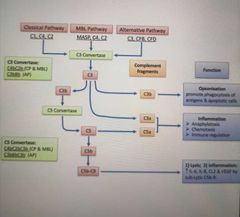
|
|
|
What is the role of T cells? |
-activate immune responses -mediate activation of B cells -rudimentary killing actions |
|
|
|
What is the role of T cytotoxic cells? |
-deal with intracellular pathogens |
|
|
|
What is the role of T helper cells? |
-support activation of B cells thus aiding in a anti-body mediated response to extracellular pathogens |
|
|
|
How are T helper cells activated? |
T-cell receptors recognise and bind to specific fragments from foreign antigens |

|
|
|
T-cells can usually only ve activated if the foreign antigen binds at the same time as a second signal. What do these second signals tend to be? |
Cytokines Plasma membrane molecules |
|
|
|
Why is it important for a second signal to be present in order to allow T-cell activation? |
To ensure the immune response doesn't happen accidently |
|
|
|
What do active T helper cells secrete? |
Cytokines (IL2 - interleukin 2) |
|
|
|
What does IL2 do? |
Triggers T cell proliferation. So when activated T cells release IL2 it reads to more T cells being made which secretes more IL2 (positive feedback)
Also acts in autocrine / paracrine manner as a costimulant for cells when antigens bind |
|
|
|
What is autocrine and paracrine? |
Autocrine-cell releasing hormone which on effects that cell Paracrine- cell releasing hormones that only effects close by cells |
|
|
|
What type of response is the adaptive response? |
Slower but more specific, with the ability to gain memory |
|
|
|
What receptor does TLR have? |
Toll-interlukin receptor (TIR) and horse shoe shaped sensor on the other side |
|
|
|
What does C3a initiate in the compliment cascade? |
Enhances inflammation |
|
|
|
What does C3b initiate in the compliment system? |
Opsonisation Lysis |
|
|
|
What will T-cells proliferate via once activated by a complimentary antigen? |
Clonal selection. This will also make memory cells |
|
|
|
What different T helper cells does CD4+ differentiate into? |

TH1 - TH2 - TH17 - TReg - |
|
|
|
What is humoral immunity? |
When differentiated B cells (now plasma cells) produce antibodies/ immunoglobulin |
|
|
|
What are the 5 Ig? |
IgG IgA IgM IgE IgD GAMED |
|
|
|
Which Ig activates compliment cascade? |
IgG IgM |

|
|
|
Which Ig is the first to be made in an immune response? |
IgM |
|
|
|
Which Ig has antimicrobial actions? |
IgA |
|
|
|
Which Ig is a cell surface antigen receptor? |
IgD |
|
|
|
Which Ig is antiallergenic and antiparasitic? |
IgE |
|
|
|
What is the primary locations of the immunoglobulins? |
IgG - circulation & tissues IgA- mucus membranes, skin, circulation IgM- circulation and b cells IgE- gut, airways, skin IgD- b cells |

|
|
|
Which immunoglobulins are responsible for neutralisation? |
IgG IgA IgM |
|
|
|
How does neutralisation work? |
Immunoglobulin binds to toxins & viruses before they can enter host cell. Thus preventing cell death. |

|
|
|
Which immunoglobulins is involved is opsonisation? |
IgG |
|
|
|
What is opsonisation? |
Where the Ig attaches to the bacteria and acts as a marker to alert macrophages to engulf it |
|
|
|
TH-1 function? (T - helper cells?) |
Cell mediated immunity |
|
|
|
TH2 function? |
Eosinophil activation Helps antibody production |
|
|
|
TH-17 function? |
Neutrophil activation |
|
|
|
Treg function? (t-regulatory) |
Immune regulation (helps prevent autoimmunity) |
|
|
|
What is a conjugate vaccine? |
A vaccine that includes polysaccharide antigen linked to a protein carrier, and induces immunity in young children under 2 and with long term memory |
|
|
|
What is an agent that activates toll-like receptors on innate immune cells such as dendritic cells to modulate an immune response? |
Adjuvent |
|

